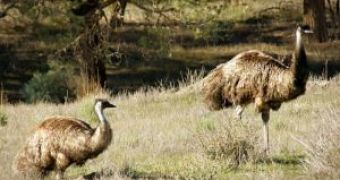Emu is the largest Australian bird and the second in the world after the ostrich.
They live from deserts of Central Australia to savannas and dry woods.
During the cool, rainy Australian winter, from May to June, when daylight hours shorten, emus start the mating ritual. Traveling during this period into the Emu land, you will be amazed by hearing some very low waves of sounds. Literally, the air is filled with this noise.
To the surprise of the first biologists who studied the emu, the vibrations like sounds are produced by females with air sacks from their chests!
These sounds are called "drumming" or "booming".
The deep rumbling sound, with its very low frequency, has properties similar to the infrasounds emitted by elephants for long distance communication, and that's why they travel far away many miles.
During the courtship, both genders start strutting and circling; ruffling out their feathers and cocking their heads in a shy posture.
The male starts a mating dance with slow, snake-like back-and-forth movements of his head while circling the female. The male needs a lot of patient persuasion to get a conquest, otherwise, the female can turn very aggressive.
Once formed, the pair may last about five months, mating every 1-2 days, and the female will lay a dark-green egg, up to 900 g (2 pounds, as big as 12 chicken eggs), every 3 to 4 days.
As the female lays her eggs, the male would group them into a rough nest of bark, grass, sticks and leaves sheltered in a small hollow built by him.
When there are already 6 to 8 eggs on the nest (but the female will continue laying more), he starts nesting, ceasing to eat, drink or defecate for 56 days, living off the thick fat layer on his back.
During this period, he will lose one third of his weight.
But don't get fooled by this touchy female image.
Despite the initial pair-bond relationship, soon after the male starts brooding, the female will look for other partners.
She uses her deep call to invite another male to begin building a new nest for her so that she can produce a second clutch.
Or not.
Sometimes, as many as half of the offspring from the initial nest may be fathered by others(or sometimes by none of the partners, as some females can deposit their eggs in totally foreign nests).
In abundant rainy seasons, she will lay up to three separate clutches.
Those low frequencies sounds will be heard by males from many miles away and will do the job of bringing them to these hot blooded chicks.

 14 DAY TRIAL //
14 DAY TRIAL //